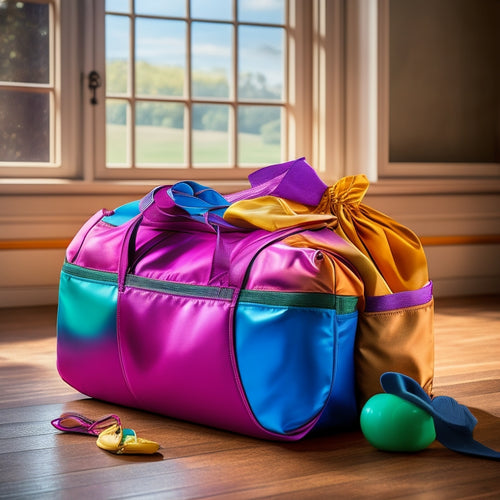Theatrical Makeup Safety Best Practices
Share
To guarantee theatrical makeup safety, it's vital to understand the hazards of products, choose safe makeup, and follow proper application techniques. Hazards include allergies, skin irritation, and long-term health consequences due to ingredients like preservatives, metals, solvents, dyes, waxes, and oils. Prioritize products from reputable manufacturers with clear labeling and safety data sheets, and conduct patch tests before use. Proper hygiene, ventilation, and storage are also essential. By following these best practices, performers can minimize risks and maintain healthy skin. As you explore the world of theatrical makeup, you'll discover even more essential considerations to prioritize performer safety and well-being.
Key Takeaways
• Conduct patch tests before using new products to identify potential allergens and skin irritations.
• Prioritize products with clear labeling, safety data sheets, and reputable manufacturers to ensure safe ingredients.
• Maintain proper hygiene during makeup application by washing hands, using clean tools, and avoiding sharing products.
• Remove makeup thoroughly after each performance using a gentle skincare routine to prevent skin irritation and maintain skin health.
• Store theatrical makeup in a cool, dry place, label and date products, and regularly inspect for spoilage or damage.
Hazards of Theatrical Makeup
A multitude of hazardous ingredients lurk in theatrical makeup, including preservatives, metals, solvents, dyes, waxes, and oils, which can trigger severe allergic reactions, skin irritation, and even long-term health consequences if not handled properly.
Formaldehyde in nail products, metals in eye makeup, and solvents in hair products can cause allergies. Hair dyes may contain carcinogens, and waxes and oils can lead to skin reactions.
To prevent these risks, it is vital to use cosmetic products specifically designed for skin application and avoid non-cosmetic products. Conducting patch tests before using products is essential to check for allergic reactions.
Choosing Safe Makeup Products
Most commercially available makeup products are formulated with safety in mind, making it important to select products from reputable manufacturers that disclose their ingredients. This guarantees ingredient transparency, allowing you to make informed decisions about the products you use. When choosing makeup products, prioritize those with clear labeling and safety data sheets. It's also essential to conduct patch testing before using new products to identify potential allergens.
| Product Criteria | Safety Considerations | Best Practices |
|---|---|---|
| Ingredient transparency | Check for disclosed ingredients | Research manufacturer credibility |
| Patch testing | Identify potential allergens | Perform tests before first use |
| Manufacturer credibility | Look for reputable brands | Verify safety certifications |
| Product labeling | Ensure clear labeling | Review instructions and warnings |
Safe Application Techniques
Proper application methods are vital in preventing the transmission of diseases and skin irritations, as they directly impact the health and well-being of performers. To guarantee a safe application process, it is important to maintain proper hygiene. This includes washing hands thoroughly before applying makeup, using clean and sanitized tools, and avoiding sharing makeup products. Additionally, performers should be instructed on how to apply makeup correctly to prevent skin irritation.
Here are some key application techniques to follow:
-
Use a clean brush or applicator for each performer to prevent cross-contamination.
-
Apply makeup in a well-ventilated area to prevent inhalation of fumes.
-
Avoid applying makeup too close to the eyes, mouth, or nose to prevent irritation.
- Use a light hand when applying makeup to prevent caking and skin irritation.
Post-Performance Makeup Removal
After each performance, performers should take the time to meticulously eliminate their makeup, as this crucial step plays a significant role in maintaining their skin health and preventing potential skin issues.
Gentle elimination is key, as harsh chemicals or abrasive techniques can strip the skin of its natural oils and cause irritation. A thorough skincare routine should be followed, including cleansing with cold cream and warm water, followed by moisturizing to hydrate the skin.
This process helps to eliminate all traces of makeup, allowing the skin to breathe and recover from the wear and tear of performance. By prioritizing post-performance makeup removal, performers can guarantee their skin remains healthy and resilient, even under the demands of regular performances.
Storage and Maintenance
In theatrical makeup storage, a cool, dry location away from direct sunlight and moisture is necessary for preserving the quality and safety of products, as well as preventing the growth of bacteria and mold.
Proper storage organization is vital to maintaining a safe and healthy environment for performers. Here are some key considerations:
-
Label and date products to make sure easy tracking of product expiration and rotation.
-
Store products in airtight containers to prevent contamination and moisture exposure.
-
Designate a specific area for makeup storage to keep a clean and organized workspace.
- Regularly inspect products for signs of spoilage or damage and discard any expired or compromised items.
Frequently Asked Questions
How Often Should I Wash My Makeup Brushes?
To uphold peak hygiene and extend makeup longevity, wash your makeup brushes daily with gentle soap and lukewarm water, and schedule professional cleaning every 1-2 months to prevent bacteria buildup and guarantee maximum performance.
Can I Share Makeup Products With Fellow Performers?
"Sharing makeup products with fellow performers is a recipe for disaster, like mixing oil and water, it's a breeding ground for cross contamination risks, compromising makeup hygiene and performer health, making it a definite no-go."
Are There Any Specific Makeup Products for Sensitive Skin?
When selecting makeup products for sensitive skin, opt for hypoallergenic options with special formulations that minimize irritation. Conduct thorough skin patch tests to guarantee compatibility, considering allergy considerations and potential reactions to guarantee safe and effective application.
What Should I Do if I Experience an Allergic Reaction to Makeup?
In the event of an allergic reaction, promptly remove the offending makeup using gentle removal techniques, identify the culprit ingredient, and explore alternative products; meanwhile, apply soothing skin sensitivity precautions and seek medical attention if symptoms persist.
Can I Use Household Items as Substitutes for Makeup Tools?
In the domain of creativity, it's tempting to MacGyver makeup tools from household items, but beware: DIY alternatives can harbor hidden dangers, perpetuating common misconceptions that compromise safety precautions and proper hygiene, ultimately putting performers' health at risk.
Related Posts
-

Elevate Your Dance Choreography With Top Video Editing Tools
You're just a few clicks away from maximizing your dance choreography potential! With top video editing tools like Ad...
-

Dancewear Bags to Keep You Organized and Stylish
When it comes to dancewear bags, you want something that's both functional and stylish. Look for durable materials li...
-

Missouri Star Unveils New Ribbon Dance Pattern
Missouri Star Quilt Co. introduces the Ribbon Dance Pattern, a vibrant 10 Square (Layer Cake) design that showcases b...


